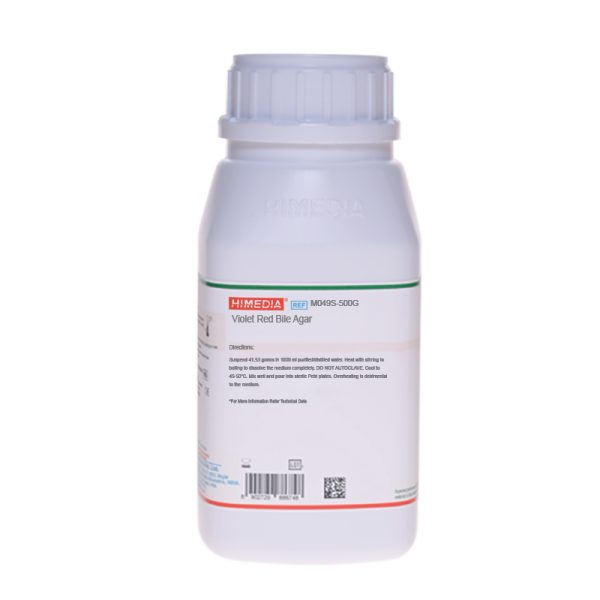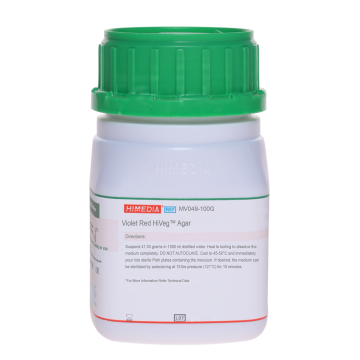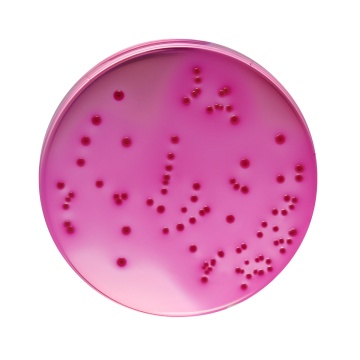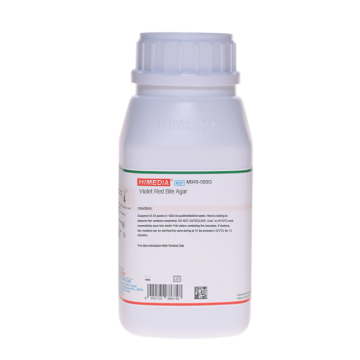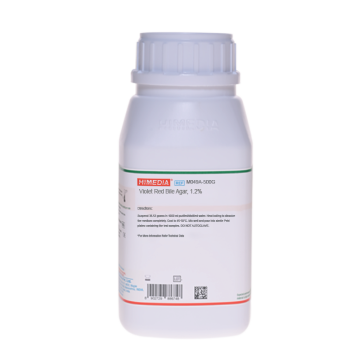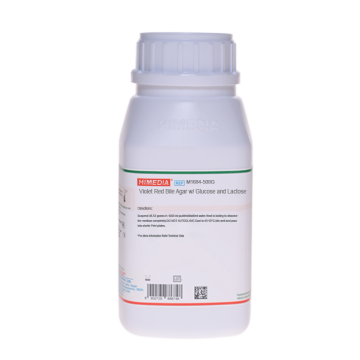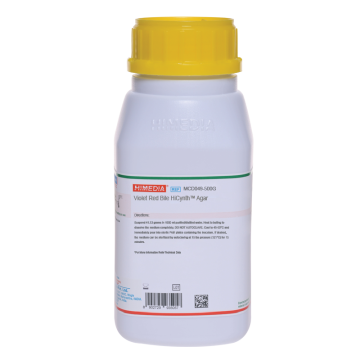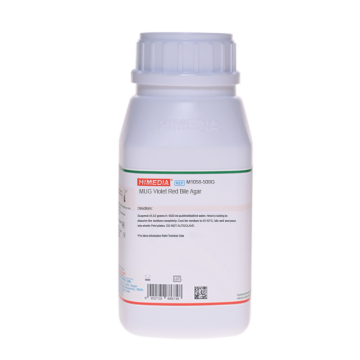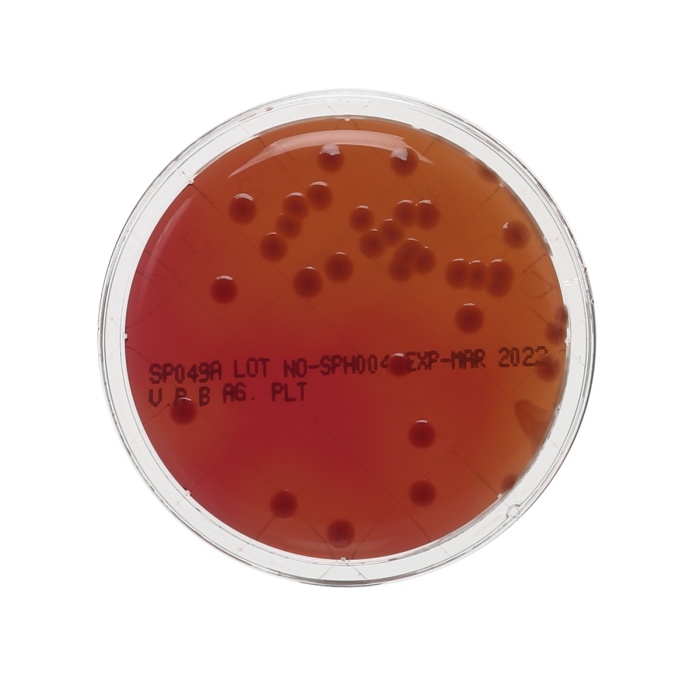 Your enquiry has been submitted
Your enquiry has been submitted
Violet Red Bile Agar
Intended Use
Recommended for selective isolation, detection and enumeration of coli-aerogenes bacteria in water, milk and other dairy food products. It is recommended by BIS committee under the specifications IS:5401(Part I) :2002.
Composition
| Ingredients | g/L |
|---|---|
| Peptone | 7.000 |
| Yeast Extract | 3.000 |
| Lactose | 10.000 |
| Bile salts mixture | 1.500 |
| Sodium chloride | 5.000 |
| Neutral red | 0.030 |
| Crystal violet | 0.002 |
| Agar | 15.000 |
Final pH (at 25°C): 7.4±0.1
Formula adjusted, standardized to suit performance parameters
Directions
Suspend 41.53 grams in 1000 ml purified / distilled water. Heat with stirring to boiling to dissolve the medium completely. DO NOT AUTOCLAVE. Cool to 45-50°C and pour into sterile Petri plates. Overheating is detrimental to the medium.
Principle And Interpretation
Violet Red Bile Agar is recommended by APHA for the detection and enumeration of coliform organisms in water, milk, dairy and other food products (1,2). It is also recommended by BIS as a presumptive test solid medium for detection and estimation of coliform bacteria in food stuff (3). Druce et al (4) found this medium equally good as the indicator of coli-aerogenes in milk as MacConkey Broth. Recently, the agar formulation is recommended by ISO committee for the enumeration of coliforms (5). The medium is selective due to the presence of the inhibitors - bile salts and crystal violet. Crystal violet inhibits gram-positive microorganisms especially Staphylococci. Organisms which rapidly ferment lactose produce red colonies surrounded by red-purple halo (6). Lactose non-fermenters and late lactose fermenters produce pale colonies. Other related gram-negative bacteria can be suppressed by incubation at > 42°C or by anaerobic incubation. An overlay method is helpful to improve the specificity of the medium. Incubation may be carried out at > 42°C for 18 hours, 32°C for 24-48 hours or 4°C for 10 days depending on the temperature characteristics of the organisms to be recovered (7).
Type of specimen
Food samples; Dairy samples; Water samples
Specimen Collection and Handling
For food and dairy samples, follow appropriate techniques for sample collection and processing as per guidelines (2,8,9). For water samples, follow appropriate techniques for sample collection, processing as per guidelines and local standards.(10) After use, contaminated materials must be sterilized by autoclaving before discarding.
Warning and Precautions
Read the label before opening the container. Wear protective gloves/protective clothing/eye protection/ face protection. Follow good microbiological lab practices while handling specimens and culture. Standard precautions as per established guidelines should be followed while handling specimens. Safety guidelines may be referred in individual safety data sheets.
Limitations
- Use freshly prepared medium
- Other biochemical tests must be carried out in conjunction for confirmation
- Due to nutritional variations, certain strains may show poor growth.
Performance and Evaluation
Performance of the medium is expected when used as per the direction on the label within the expiry period when stored at recommended temperature.
Quality Control
Appearance: Light yellow to pink coloured homogeneous free flowing powder
Gelling: Firm, comparable with 1.5% Agar gel
Colour and Clarity of prepared medium: Reddish purple clear to slightly opalescent gel forms in Petri plates.
Reaction: Reaction of 4.15% w/v aqueous solution at 25°C. pH: 7.4±0.1
pH: 7.30-7.50
Cultural Response
Cultural characteristics observed after an incubation at 35-37°C for 18-24 hours.
| Organism | Inoculum (CFU) | Growth | Recovery | Colour of Colony |
|---|---|---|---|---|
| # Klebsiella aerogenes ATCC 13048 (00175*) | 50-100 | luxuriant | >=50% | pink |
| Escherichia coli ATCC 25922 (00013*) | 50-100 | luxuriant | >=50% | pinkish red with bile |
| Salmonella Enteritidis ATCC 13076 (00030*) | 50-100 | luxuriant | >=50% | precipitate colourless |
| Staphylococcus aureus subsp. aureus ATCC 25923 (00034*) | >=104 | inhibited | 0% |
Key: (*) Corresponding WDCM numbers.
(#) Formerly known as Enterobacter aerogenes
Storage and Shelf Life
Store between 10-30°C in a tightly closed container and use freshly prepared medium. Use before expiry date on the label. On opening, product should be properly stored dry, after tightly capping the bottle in order to prevent lump formation due to the hygroscopic nature of the product. Improper storage of the product may lead to lump formation. Store in dry ventilated area protected from extremes of temperature and sources of ignition. Seal the container tightly after use. Product performance is best if used within stated expiry period.
Disposal
User must ensure safe disposal by autoclaving and/or incineration of used or unusable preparations of this product. Follow established laboratory procedures in disposing of infectious materials and material that comes into contact with sample must be decontaminated and disposed of in accordance with current laboratory techniques (11,12).
Reference
- Richardson G. (Ed.), 1985, Standard Methods for the Microbiological Examination of Dairy Products, 15th ed., APHA, Washington, D.C.
- Salfinger Y., and Tortorello M.L., 2015, Compendium of Methods for the Microbiological Examination of Foods, 5th Ed., American Public Health Association, Washington, D.C.
- Bureau of Indian Standards, IS: 5401(Part I) :2002.
- Druce R.G. et al, 1957, J. Appl. Bact., 20: 1.
- International Organization for Standardization (ISO), 1991, Draft ISO/DIS 4832.
- Davis J.G., 1951, Milk Testing, Dairy Industries Limited, London; pg 131
- Mossel D.A.A. and Vega C.L., 1973, Hlth. Lab. Sci., 11:303.
- American Public Health Association, Standard Methods for the Examination of Dairy Products, 1978, 14th Ed., Washington D.C.
- Wehr H. M. and Frank J. H., 2004, Standard Methods for the Microbiological Examination of Dairy Products, 17th Ed.,APHA Inc., Washington, D.C.
- Lipps WC, Braun-Howland EB, Baxter TE, eds. Standard methods for the Examination of Water and Wastewater, 24th ed. Washington DC:APHA Press; 2023.
- Isenberg, H.D. Clinical Microbiology Procedures Handbook 2nd Edition.
- Jorgensen, J.H., Pfaller, M.A., Carroll, K.C., Funke, G., Landry, M.L., Richter, S.S and Warnock., D.W. (2015) Manual of Clinical Microbiology, 11th Edition. Vol. 1.
| Product Name | Violet Red Bile Agar |
|---|---|
| SKU | M049S |
| Product Type | Regular |
| Physical Form | Powder |
| Origin | Animal |
| Packaging type | HDPE |
| References | 1. Eaton A. D., Clesceri L. S. and Greenberg A. E., (Ed.), 1998, Standard Methods for the Examination of Water andWastewater, 20th Ed., American Public Health Association, Washington, D.C. 2.Downes F. P. and Ito K., (Ed.), 2001, Compendium of Methods for the Microbiological Examination of Foods, 4th Ed.,American Public Health Association, Washington, D.C. 3.MacConkey A., 1905, J. Hyg., 5, 333-379 4.Corry J. E. L., Curtis G. D. W. and Baird R. M., (Ed.), 1995, Culture Media for Food Microbiology, Vol. 34, Progress inIndustrial Microbiology, Elsevier, Amsterdam. 5.Marshall R. T., (Ed.), 1992, Standard Methods for the Examination of Dairy Products, 16th Ed., APHA, Washington, D. C. 5.International Organization for Standardization (ISO), 1991, Draft ISO/DIS 4382 6.Mossel D. A. A. and Vega C. L., 1973, Hlth. Lab. Sci., 11:303 |
| Customized Product Available | No |



